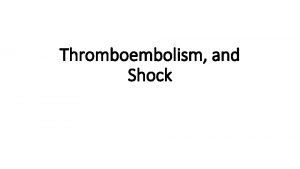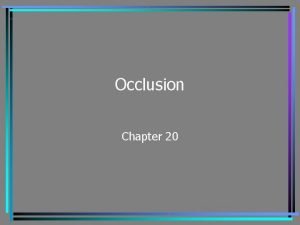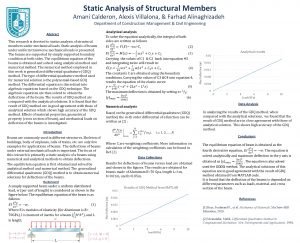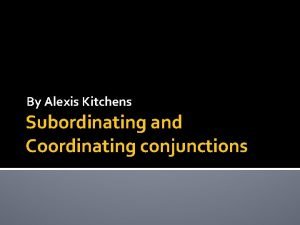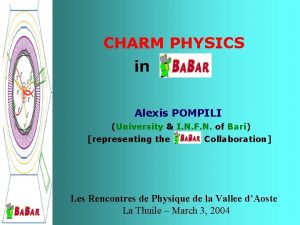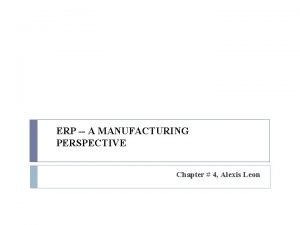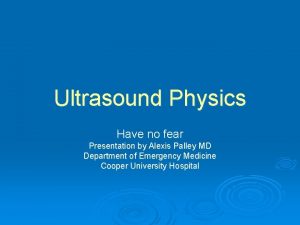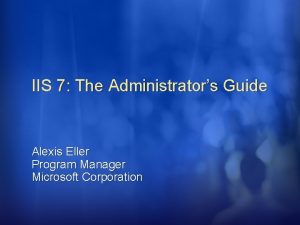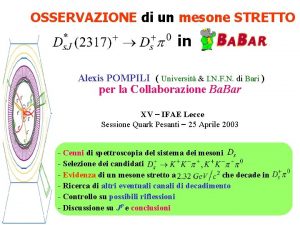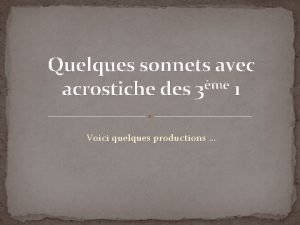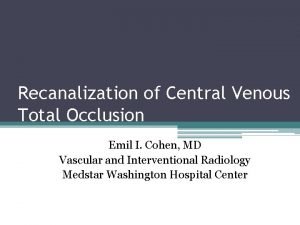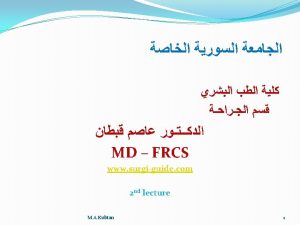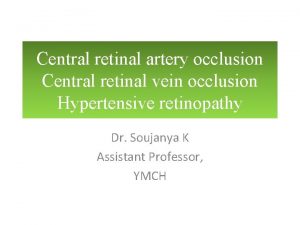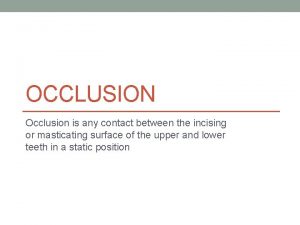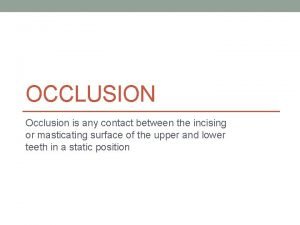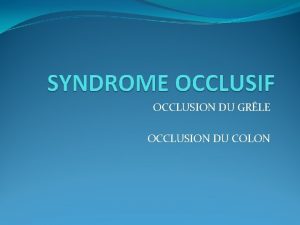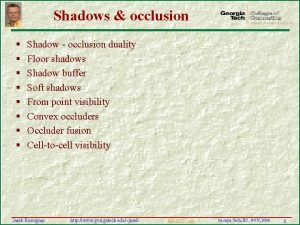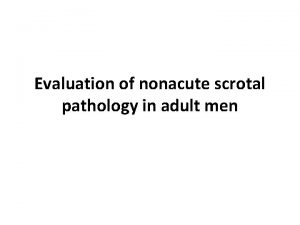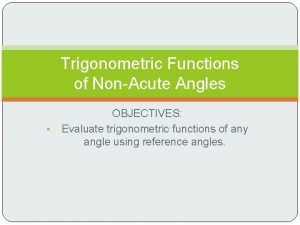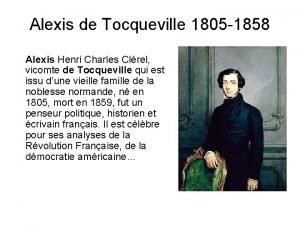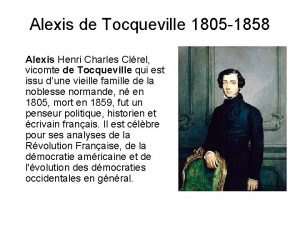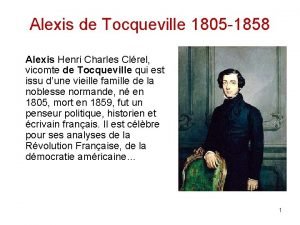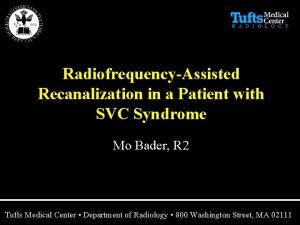NonAcute TIPS Occlusion Recanalization vs Parallel TIPS Alexis































- Slides: 31

Non-Acute TIPS Occlusion; Recanalization vs. Parallel TIPS Alexis M. Cahalane Kei Yamada Department of Interventional Radiology Massachusetts General Hospital

Background • 31 YO M • 15 months prior to transfer to MGH • • Presented to OSH with abdominal distension & UGIB Grade III esophageal varices – endoscopic banding Alcohol-related cirrhosis TIPS 1 month later for persistent variceal bleeding • Course initially complicated by hepatic encephalopathy but improved with lactulose & rifaximin • No GI follow up • PMH • Asthma • ADHD

TIPS

Presentation No. 1 • Three weeks prior to transfer to MGH • Presented to OSH with large volume hematemesis • ICU admission requiring intubation • EGD • Grade III EV in mid/lower esophagus without active bleeding • Variceal band ligation x 5 • 5 u p. RBCs • US • Thrombosed TIPS • Unsuccessful attempt at TIPS recanalization • Discharged after five day hospitalization with plan for GI follow up • Stable Hb 7. 8 g/d. L

US

Presentation No. 2 • Four days after discharge • Represented to OSH with recurrent hematemesis • Hb 7. 3 g/d. L • Repeat EGD • Multiple banded ulcers in mid/lower esophagus & gastric cardia without active bleeding • Hospitalization course; • RIGHT hepatic hydrothorax – chest drain • Four days after admission • Recurrent hematemesis • EGD • Actively bleeding ulcer in mid-esophagus • Treated with six clips & epinephrine • 6 u p. RBCs • Transferred to MGH for revision of TIPS • Hb 8 g/d. L

Presentation No. 2 • MELD-Na: 17 • MELD: 12 • • Serum Creatinine Serum Na Total Bilirubin INR 0. 58 mg/d. L 132 mmol/L 0. 7 mg/d. L 1. 6

Options? Recanalization Versus Parallel TIPS


Stent Position

Recanalization Tanaka et al (2011), CVIR 34: 406 -412

Recanalization • Components • Mechanical thrombectomy • Catheter-directed thrombolysis • +/- stent placement • Access • Conventional via RIGHT IJV access • Advanced techniques • Percutaneous transhepatic approach • Trans-splenic venous approach

Recanalization Attempt • RIGHT IJV access • Standard micropuncture technique • 10 Fr x 40 cm vascular sheath • RIGHT hepatic vein access • Extra-stiff 0. 035 Amplatz guidewire • 5 Fr C 2 catheter • Attempted recanalization of TIPS stent • Angled 0. 035 glidewire • 5 Fr MPA catheter • Unsuccessful

Advanced Recanalization Techniques • Percutaneous transhepatic approach • Percutaneous puncture of caudal end of stent • Snaring a wire cephalad via RIGHT IJV access • Trans-splenic approach • Percutaneous puncturing of spleen • Access small peripheral splenic vein – portal vein • Both techniques describe tract embolization • n-butyl-2 -cyanoacrylate and lipiodol • coils

What Next? • Parallel TIPS • Why? • Duration of TIPS stent occlusion • Angulation & position of stent

Parallel TIPS – 1 st Attempt PA RAO 19 o

Parallel TIPS – 2 nd Attempt

Parallel TIPS

Parallel TIPS

Parallel TIPS

Parallel TIPS

Options? Embolization? YES √ Or NO X

Embolization Pros • Limit variceal filling/recanalization • Reduce risk of recurrent hemorrhage due to shunt dysfunction • Relevance in PTFE era? Cons • Increased • Procedure duration • Cost • Radiation exposure • Small incidence of postembolization syndrome with sclerosing agents

Embolization • Variceal bleeding • 90 -100% immediate cessation of bleeding s/p TIPS • 17 -24% recurrent bleeding • Does it make a difference? • Meta-analysis of six studies • TIPS & variceal embolization • Lower incidence of variceal rebleeding • Similar incidence of shunt dysfunction, HE & death • Heterogenous studies

Parallel TIPS • Balloon angioplasty reduced thrombus burden in MPV • Decision made to coil embolize the coronary vein to improve hepatopetal portal flow • Reduced chance of thrombus propagation • ? Avoid need for anticoagulation • Reduction in portosystemic gradient • Pre: 18 mm. Hg • Post: 9 mm. Hg

Parallel TIPS

Post Parallel TIPS • Patent TIPS on US 48 hours post-procedure • No hepatic encephalopathy • Normal diet • Lactulose and rifaximin restarted • During TIPS • Incidental diagnosis of non-occlusive RIGHT IJV thrombus • Likely catheter-related 2/2 CVC at OSH • New diagnosis PFO & variceal bleeding • Patient commenced on heparin gtt 2 days post-procedure • Transitioned to dabigatran 150 mg PO 7 days post-procedure • Chosen because of available reversal agent

Follow Up • Discharged 10 days post-procedure • Local GI service • Repeat US neck to determine length of anticoagulation • Dabigatran for 3 months • Diuretics • Furosemide 20 mg P Q 24 H • Spironolactone 100 mg PO Q 24 H • Nadolol 40 mg PO Q 24 H • Lactulose 30 mls PO Q 6 H • Rifaximin 550 mg PO Q 12 H

TIPS Occlusion • 1 year patency rates • Bare metal stents: 36 -50% • Expanded PTFE-covered stents: 76 -84% • MGH institutional follow-up post-TIPS • US and IR Clinic follow up • 4 weeks post-procedure, then every six months

References • Chan C-Y & Liang P-C. Recanalization of an Occluded Intrahepatic Portosystemic Covered Stent via the Percutaneous Transhepatic Approach. Korean J Radiol (2010) 11(4) • Gaba RC. Transjugular Intrahepatic Portosystemic Shunt Creation With Embolization or Obliteration for Variceal Bleeding. Tech Vasc Interventional Rad (2016) 19: 21 -35 • Haskal ZJ, Duszak Jr. , R & Furth ER. Transjugular Intrahepatic Transcaval Portosystemic • Shunt: The Gun-Sight Approach. JVIR (1996) 7: 139 -142 • Kim SK, Belikoff BG, Guevara CJ & Park SJ. An Algorithm for Management After Transjugular Intrahepatic Portosystemic Shunt Placement According to Clinical Manifestations. Dig Dis Sci (2017) 62: 305– 318. • Larson M, Kirsch D & Kay D. Parallel Transjugular Intrahepatic Portosystemic Shunt (TIPS) in the Setting of TIPS Occlusion. Ochsner Journal (2016) 16: 113– 115. • Majdalany BS, Elliott ED, Michaels AJ & Hanje AJ. Radiofrequency Wire Recanalization of Chronically Thrombosed TIPS. Cardiovasc Intervent Radiol (2016) 39: 1040– 1044. • Miraglia R, Maruzzelli L & Luca A. Recanalization of occlusive transjugular intrahepatic portosystemic shunts inaccessible to the standard transvenous approach. Diagn Interv Radiol (2013) 19: 61– 65 • Qi X, Liu L, Bai M, Chen H, Wang J, Yang Z, Han G & Fan D. Transjugular intrahepatic portosystemic shunt in combination with or without variceal embolization for the prevention of variceal rebleeding: A meta-analysis. Journal of Gastroenterology and Hepatology (2014) 29: 688– 696 • Tanaka T, Gunther RW, Isfort P, Kichikawa K & Mahnken AH. Pull-Through Technique for Recanalization of Occluded Portosystemic Shunts (TIPS): Technical Note and Review of the Literature. Cardiovasc Intervent Radiol (2011) 34: 406 -412.

Questions? Thank You
 Portal vein recanalization
Portal vein recanalization Monoplane occlusion definition
Monoplane occlusion definition Class 1 occlusion
Class 1 occlusion Parallel and non parallel structure
Parallel and non parallel structure Parallel structure meaning
Parallel structure meaning Owl parallel structure
Owl parallel structure Deduce the resultant of two like parallel forces
Deduce the resultant of two like parallel forces Parallel and non parallel structure
Parallel and non parallel structure It refers to the focal terminus of the fingerprint pattern?
It refers to the focal terminus of the fingerprint pattern? Parallel input parallel output
Parallel input parallel output Gort-5 score interpretation
Gort-5 score interpretation Alexis de tocqueville five values
Alexis de tocqueville five values Alexis quintana
Alexis quintana Alexis schauss nc dpi
Alexis schauss nc dpi Farhad alinaghizadeh
Farhad alinaghizadeh Alexis johnston
Alexis johnston Alexis kitchens
Alexis kitchens Dorothea puente younger
Dorothea puente younger Alexis pompili
Alexis pompili Alexis joy d'achille obituary
Alexis joy d'achille obituary Alexis farah
Alexis farah Alexis butterworth
Alexis butterworth Alexis carr
Alexis carr Erp manufacturing perspective
Erp manufacturing perspective Alexis z gall
Alexis z gall Alexis eller
Alexis eller Alexis pompili
Alexis pompili Alexis ginsberg
Alexis ginsberg Acrostiche camille
Acrostiche camille Alexis de tocqueville apush
Alexis de tocqueville apush Sabrina george
Sabrina george Alexis noel
Alexis noel
